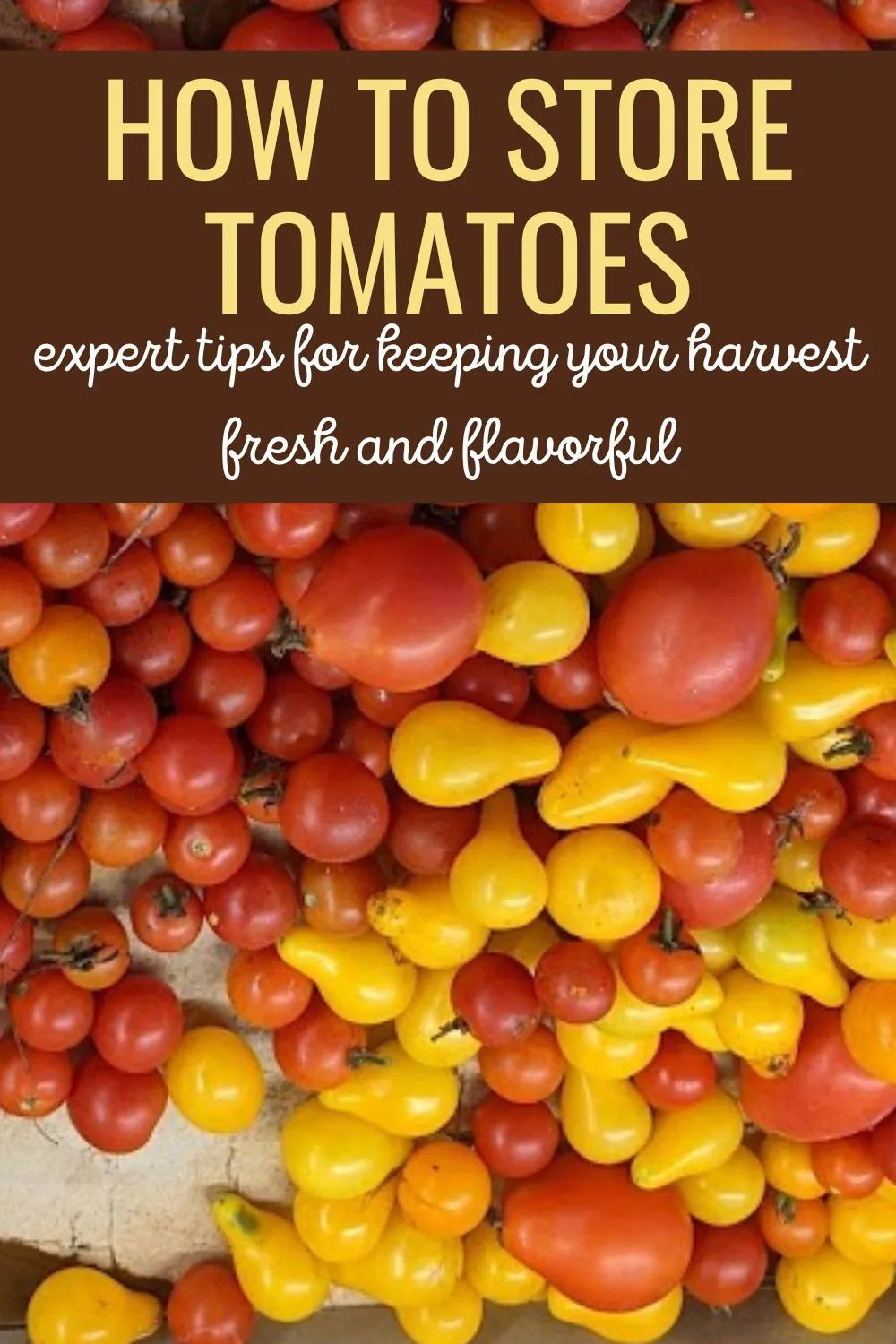Nothing is more satisfying to a home gardener than when their crops come up and they see all the fresh vegetables ready to be enjoyed. However, there are times when an overabundance of tomatoes leaves new gardeners wondering how to store tomatoes to keep them from spoiling faster than you can eat them. After all, you can only quickly eat so many fried green tomatoes, sliced ripe tomatoes, salads with tomatoes, and other tomato dishes. So it helps to learn how to store short and long-term tomatoes so you can enjoy the fruits of your labor both now and throughout those winter months.

How to Store Tomatoes Properly Short Term
Properly storing homegrown tomatoes is essential for preserving their freshness, flavor, and texture, especially when you have an abundant harvest (we always plant way more plants than our family needs).
So, why might you want to store tomatoes? Here are a few scenarios from my experience:
- you planted the same type of tomato at the same time, so all are ripening at once
- you planted more than your family can eat
- you purchased a large quantity of tomatoes from a farmer’s market
- you want to save enough tomatoes to prepare something for the winter
By employing the right techniques, you can prevent spoilage, maintain their quality, and savor the vibrant taste of ripe tomatoes even beyond their peak season.
How to store ripe tomatoes short term
Once a tomato ripens on the vine, you must pick it up immediately, or it will lose its quality. This often means that you end up picking more tomatoes than you can eat immediately. You can store your ripe tomatoes short term for two or three days simply by placing them on your kitchen counter out of direct sunlight with stem (or stem scar) side up; this will reduce the softening of the fruit.
Should your tomatoes become over-ripe, you can place them in an airtight container and store them in the refrigerator for another two or three days.
How to store cut tomatoes in the refrigerator
Once you have cut or sliced a tomato, you must immediately store the leftovers in the refrigerator.
Tomatoes cut in half should be wrapped in a paper towel to absorb as much moisture as possible, and then place the half or halves of tomatoes into an air-tight container in the refrigerator. Leftover sliced tomatoes are placed in an air-tight container and stored in the refrigerator. Once refrigerated, you need either eat them within a day or two or cook and freeze them.
How to store cherry tomatoes (grape tomatoes, too!) for short term
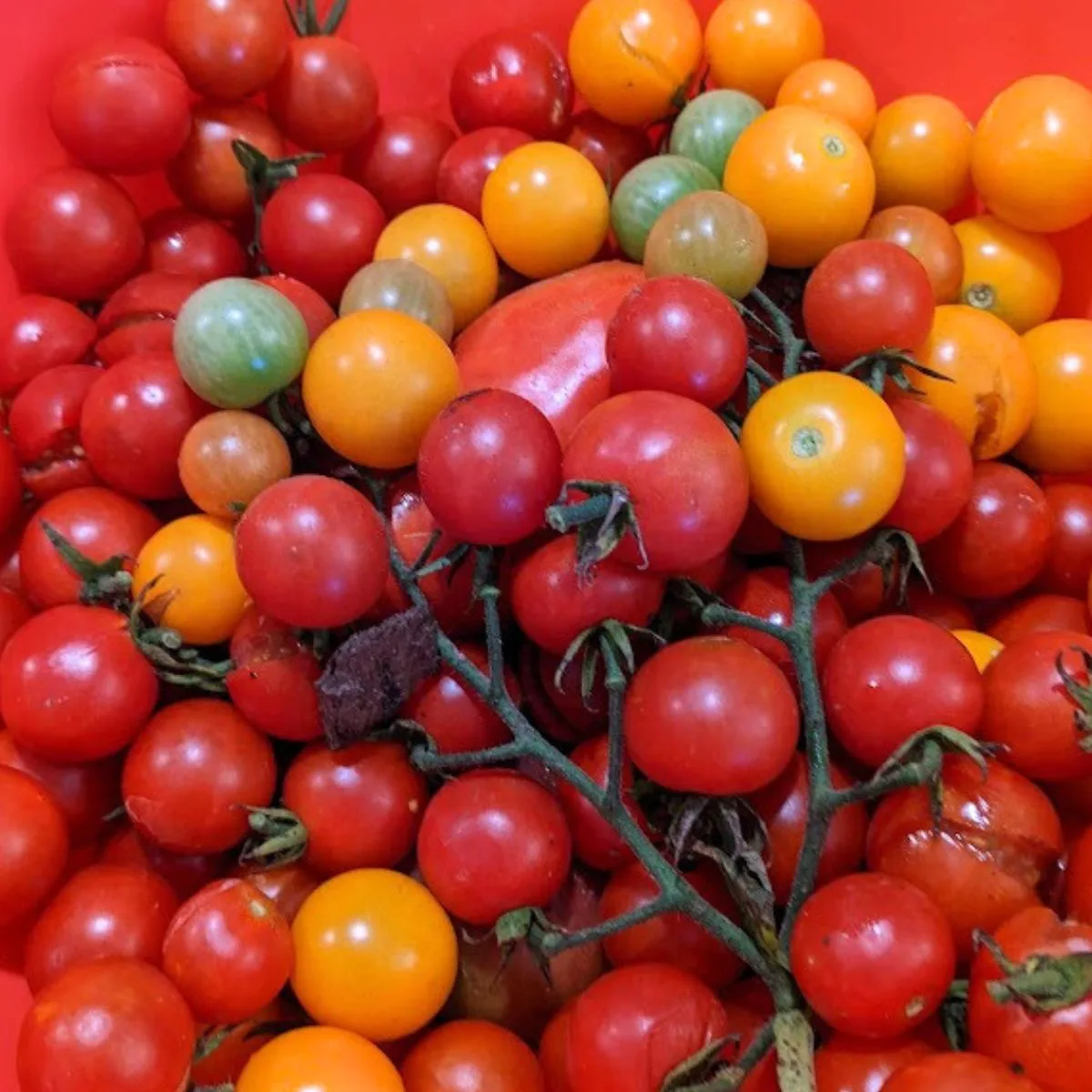
Due to their much smaller size, many people are confused about how to store cherry or grape tomatoes for the short term. Actually, storing these two types of tomatoes for two or three days is relatively straightforward: place them in a bowl and store them on your counter out of direct sunlight. Doing so will allow easy snacking on these tasty little gems whenever you want. You can store the tomatoes on the countertop for 2 or 3 days.
If your cherry/grape tomatoes have reached the peak of ripeness, you can extend their life another 2 or 3 days by refrigerating them in an air container.
How to store roasted tomatoes
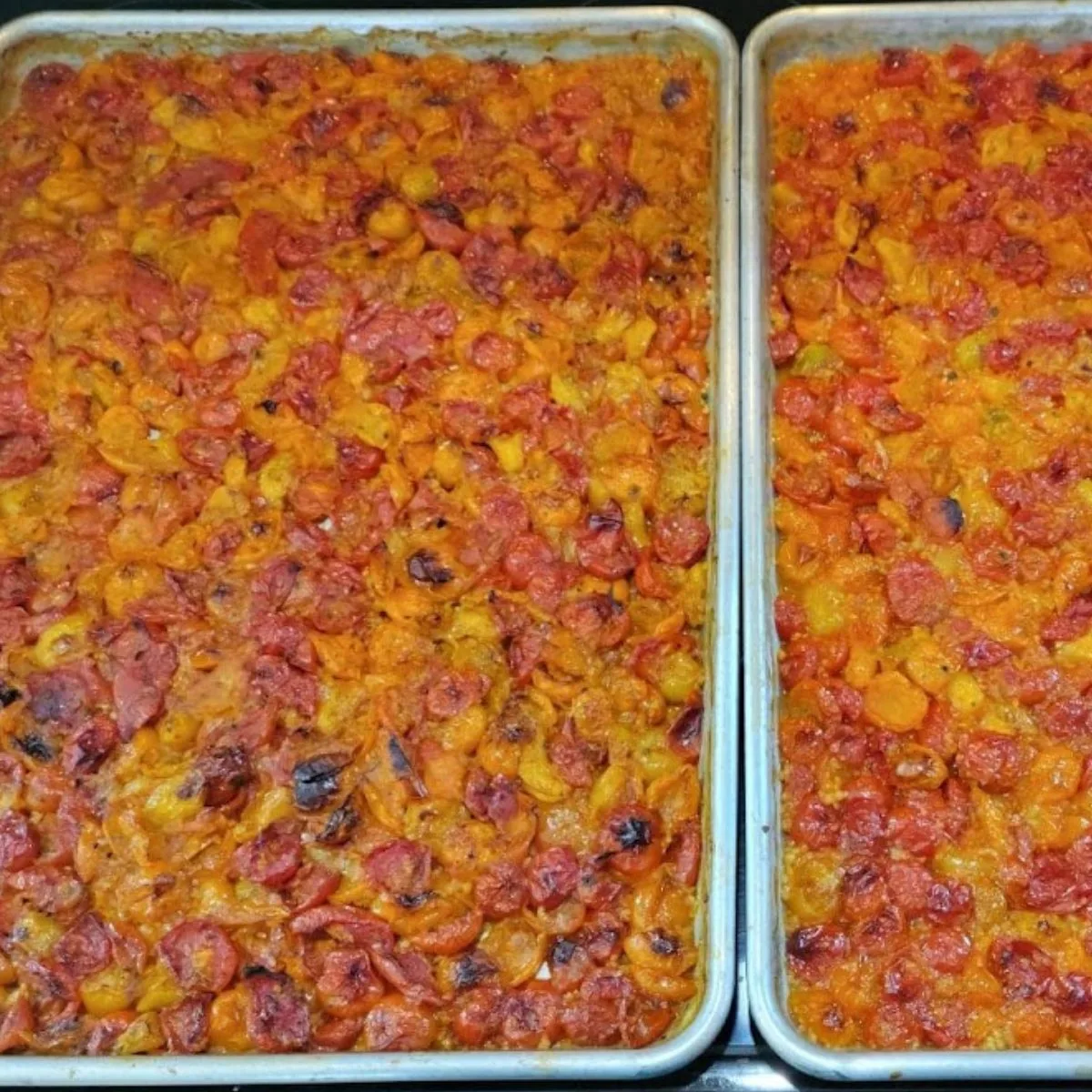
Store slow-roasted tomatoes in an airtight container in the refrigerator for up to a week. But if you make more than you can eat, you can freeze them for up to 6 months. I suggest you use freezer-proof containers and label anything in the freezer for easy identification.
How to store green tomatoes and get them to ripen

Sometimes, you will find good unripe tomatoes lying on the ground, or you must pick tomatoes while they are still green to prevent them from getting ruined by a frost. Knowing how to store those green tomatoes so that they ripen will allow you to enjoy more of your harvest.
The best way to store green tomatoes to ripen is to take a cardboard box and line it with paper bags or newspaper. You then need to place the green tomatoes in the box, stem side down, and place the box in a cool place (not too cold).
It would be best to leave the tomatoes in the box until they ripen, but remove each tomato from the box as it ripens.
Freezing tomatoes you are planning to use within a month or two
If you plan on using the tomatoes you freeze within a month or two after freezing them, you don’t have to blanch them before freezing.
To freeze Roma tomatoes, core and remove the seeds and then cut the tomatoes into 1-inch chunks.
Once cut, place the pieces of tomatoes on a baking sheet lined with parchment paper in a single layer and freeze for 4 hours or more. Once frozen, remove from baking sheet and place in a zip lock bag, label with date, and place back in the freezer.
With other types of full-size tomatoes, including heirloom tomatoes, simply core, cut into chunks, and freeze for 4 to 6 hours on the baking sheet lined with parchment, and then place in a dated zip lock bag and return to the freezer.
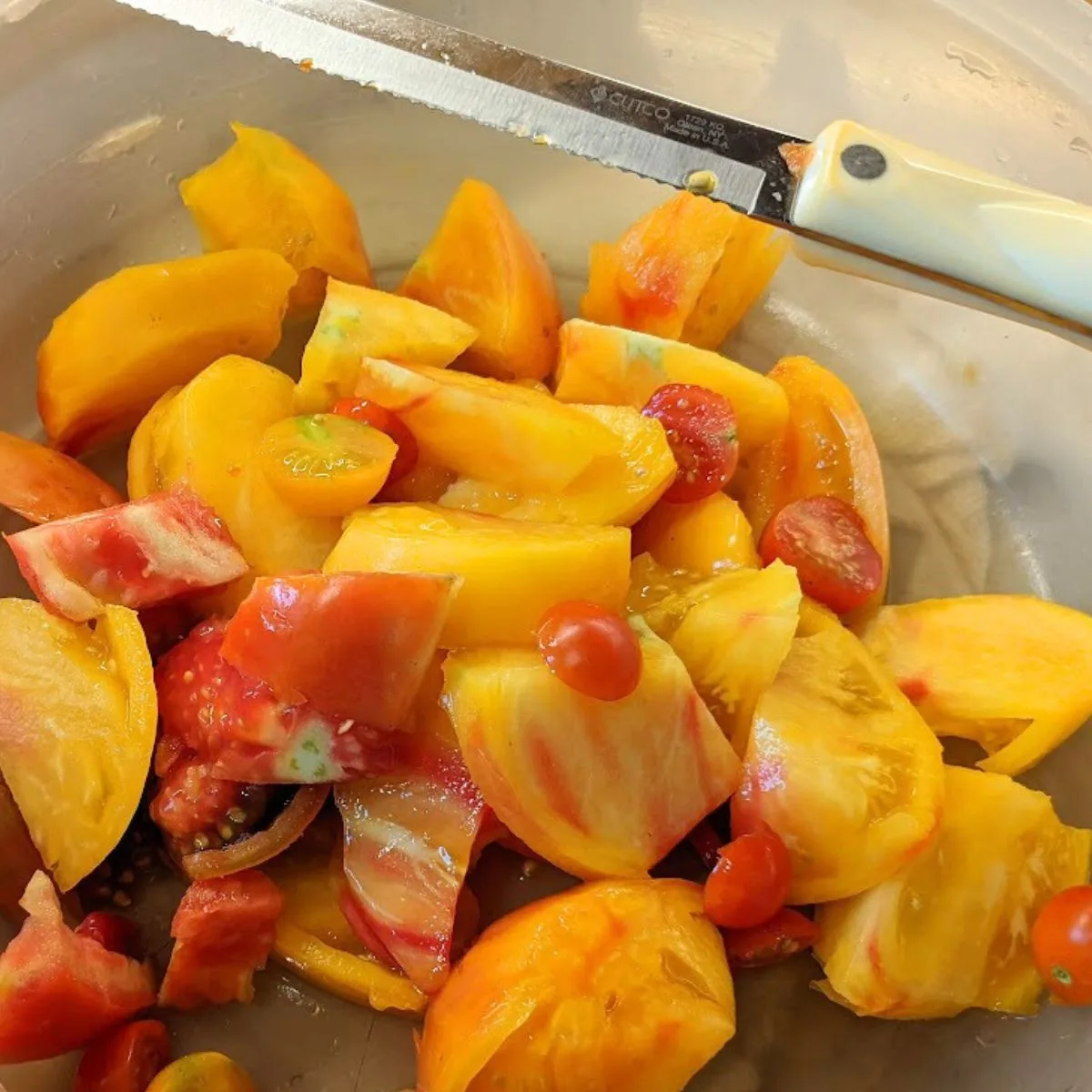
When freezing tomatoes in a zip lock bag or sealed container, fill the bag or container only 2/3 full.
How to Store Tomatoes Long Term
A fresh tomato is best, but there comes a time during the height of summer when preserving the harvest is very important. There are a few different ways to store tomatoes long-term:
- freeze them
- sun dry them
- dry them using a dehydrator
- use them in canned goods
Freezing tomatoes is probably the easiest way to store tomatoes long term. There are various ways to freeze tomatoes and each method has its advantages.
When choosing tomatoes to freeze, you want to choose tomatoes that are firm and richly colored.
How to freeze tomatoes for the long term
If you are planning on freezing tomatoes to use throughout the entire winter, then you will need to blanch them before freezing. Fill a large pan with water and set to boil (about 7 to 8 quarts). Also, prepare a bowl of ice water to stop the cooking process once the tomatoes are blanched.
To prepare the tomatoes for blanching, wash them under cool water to remove any dirt or debris on the tomatoes. Cut a shallow X in the bottom of each tomato. (This makes the tomato easier to peel after blanching.)
Place the tomatoes into the boiling water and boil until the skin of the tomatoes split open. Using a slotted spoon, transfer the tomatoes to the bowl of ice to stop the cooking process and cool off the tomatoes.
Once the tomatoes are cooled enough, peel off the skin and core the tomatoes. You can either freeze the tomatoes whole or cut them into chunks and freeze them. Again, freeze the container or ziplock bag 2/3 full.
How to freeze crushed tomatoes
Sometimes you just don’t have the time to mess with your tomato harvest, or you have split and cracked fruit that needs cutting and prepping more than a nice whole tomato. You also need to act fast before your delicious maters start to deteriorate.
In those cases, use your blender or food processor to slightly crush the fruit and stick them in freezer bags. So easy!
How to freeze roasted tomatoes
When you freeze roasted tomatoes, they maintain much of their roasted flavor, which many people love. Best of all, you can roast almost any type of tomato and then freeze them so you don’t lose your harvest.
To roast big tomatoes, preheat your oven to 400 degrees Fahrenheit. Remove the core from each tomato cut in half (if roasting Roma tomatoes, remove the seeds.) Toss the tomatoes in olive oil, salt, pepper, a little garlic powder, and sweet basil.
Place the tomatoes on a baking sheet, and roast until they are softened and slightly brown. This takes about 45 minutes. Allow to cool, and then place in a zip lock bag and freeze.
For cherry tomatoes, simply remove the green tops and roast at 400 degrees Fahrenheit and roast for 15 or 20 minutes until soft.
Tip: When using zip lock bags for freezing your tomatoes, use regular zip locks, not the type with the slider that zips the bags, because the slider bags are more apt to leak. In addition, the thicker the bags, the better the bag is for freezing tomatoes. These bags are my favorites.
What to do with frozen tomatoes?
As you can probably imagine, frozen tomatoes can not be used in salads. But there are a lot of ways to use them once your garden is done for the year:
- use them in soups and strews
- add them to vegetable smoothies, or blend it alone into a delicious tomato juice
- use them as a base for a pasta sauce
- transform them into tomato jam
- make tomato relish
How to dry tomatoes
Preserving tomatoes through dehydration is another way to store them long term. But not all tomatoes can be dehydrated, and this method takes a long time to process. Nonetheless, some gardeners love drying their tomatoes. Some even make tomato powder.
There are a few ways to dehydrate tomatoes. Here are the most popular methods of drying herbs, fruits, and vegetables:
- sun drying
- oven drying
- dehydrator drying
- microwave drying
Canning tomatoes
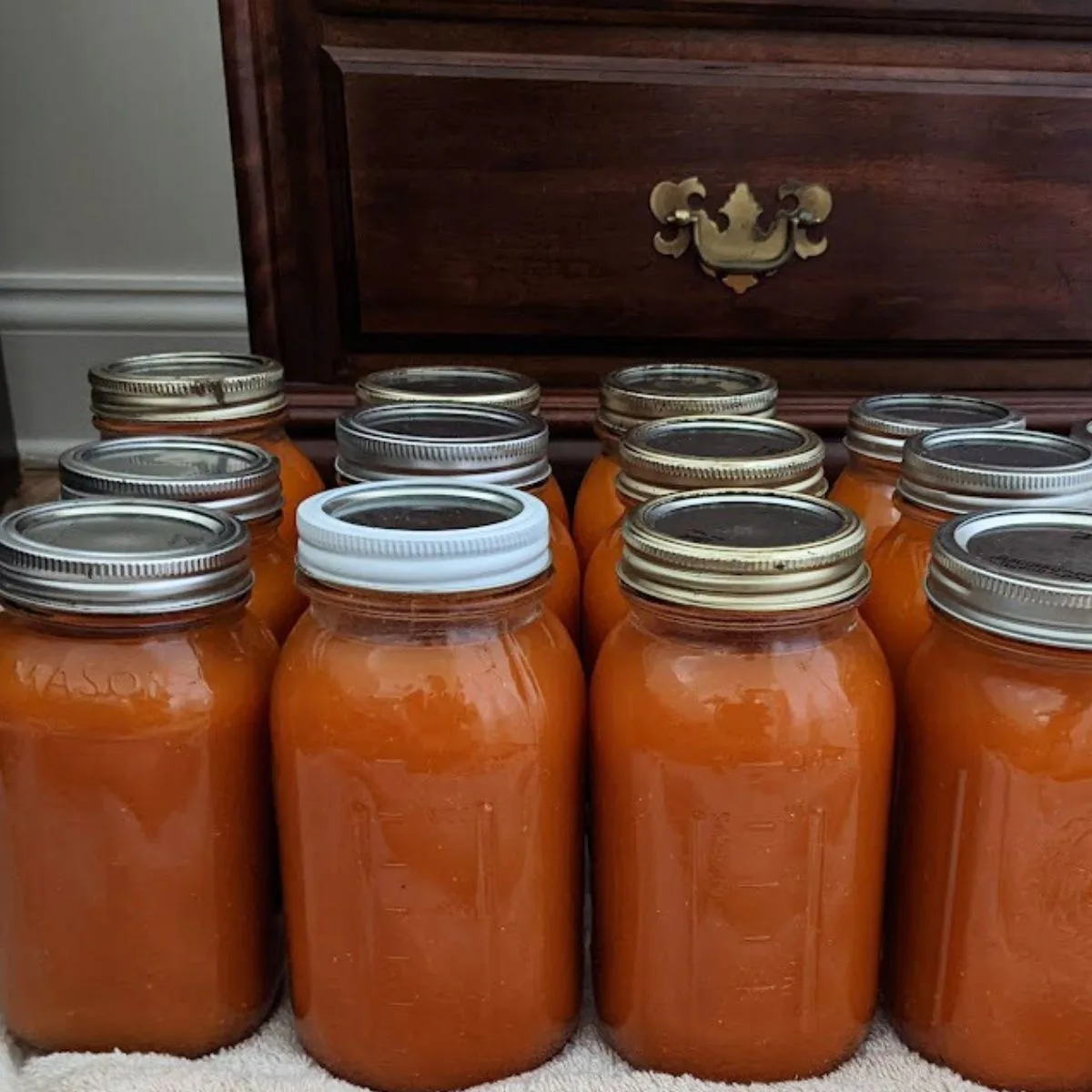
Another popular method of storing tomatoes long term is canning them: just use proper canning guidelines to keep your family safe. If you want to use this method for some of your harvests, here are some helpful guides:
- best tomatoes for canning salsa
- Ball canning supplies and accessories
- canning tips for beginners
- top 5 pressure canners
- easy tomato canning recipes
FAQs
How long can I store tomatoes in the freezer?
It’s best if you use your frozen tomatoes within a year. But, if you use a vacuum sealer, they can last up to 3 years.
Should I blanch tomatoes before freezing them?
No, you don’t need to blanch tomatoes before freezing.
Can I use frozen tomatoes directly in recipes without thawing?
It depends: if you froze them with the skin on and your recipe calls for skinned tomatoes, you’ll need to thaw them first. But if you’re making soup or sauce, go ahead and throw them in straight from the freezer.
Can I freeze tomatoes with the skin on?
Absolutely! I prefer this method, as it saves a lot of time, and the results are just as tasty. If you must remove the skin, it’s easy to do it once the tomatoes thaw. But, most of the time, you don’t necessarily need to remove the skin.
Now that you know how to store tomatoes in various ways, you no longer have to worry about part of your tomato harvest going to waste.
